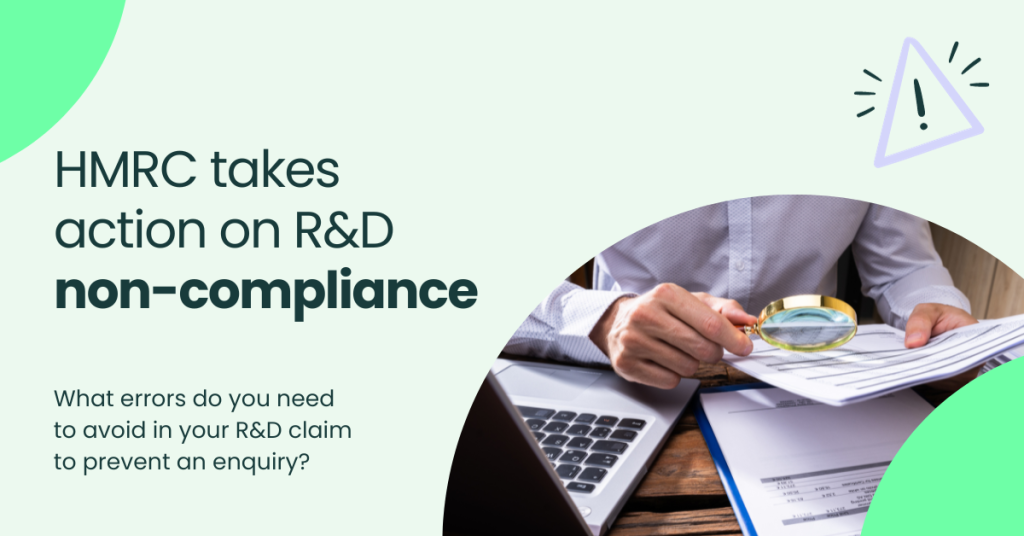HMRC are clamping down on fraud and errors to tackle R&D tax relief abuse
21 November 2023

Earlier this year, HMRC published their findings on fraud and errors in R&D claims and highlighted how there is growing concern over abuse of the initiative that financially rewards legitimate innovation. Naturally, a scheme that offers financial support to businesses will contain an inevitable risk. However, this risk seems to be growing at an unpredictable rate in recent years. It’s important that the tax benefit only goes towards businesses that are embarking on moving past scientific or technical uncertainty. This article will provide key information about HMRC’s stats, how they’re clamping down on fraud, and guidance on how to prevent your claim from being flagged as non-compliant.
The spectrum of fraud and errors in R&D claims
To understand fraudulent and erroneous R&D claims, let’s ensure we know the key terminologies used by HMRC.
Non-compliance
Non-compliance with the R&D initiative occurs when a business does not adhere to the rules and guidelines specified by HMRC for claiming R&D tax credits. The consequences of non-compliance involve time-consuming enquiries that could result in a rejection or reduction of R&D tax credits. HMRC may also impose penalties and interest for errors or omissions in the claims process. However, non-compliance is generally considered unintentional or due to a lack of understanding of the rules. Examples of non-compliance include:
- Failing to meet the eligibility criteria for R&D activities
- Inadequate documentation of R&D projects and expenses
- Misinterpretation of qualifying R&D activities
- Failure to segregate qualifying and non-qualifying R&D activities accurately
Fraud
Fraud involves deliberate and dishonest actions with the intent to deceive HMRC for financial gain. In the context of the R&D initiative, fraudulent activities may include falsifying documents, manipulating data, inflating expenses, or engaging in duplicate claims to maximise benefits. This deliberate intention to abuse R&D tax credits is a serious offence and can result in severe penalties, including fines, criminal prosecution, and imprisonment.
HMRC’s statistics on fraud and errors in R&D claims
HMRC released statistics on the level of non-compliance. According to HMRC’s analysis, the total error and fraud rate for both SME and RDEC reliefs in the fiscal year 2020-21 is 16.7%, equivalent to £1.13 billion. This figure is notably higher than the earlier reported estimate of 3.6% for the same period. One billion is lost each year; this money is supposed to be injected into businesses that are making productive changes that are positively impacting our planet, communities, and the way industries run as a whole.
They have identified that the largest proportion of non-compliant instances were within the SME scheme, with an estimated 24.4% attributed to error and fraud in the fiscal year 2020-21. In monetary terms, this is around £1.04 billion. In contrast, the RDEC incentives exhibited a considerably lower estimated rate of 3.6% for error and fraud in claims during the same period.
How are HMRC tackling fraud and errors in R&D claims?
In light of the rate of fraud and error within R&D, HMRC is taking a proactive approach to protecting the schemes. This approach comes in the form of policy changes to R&D that were in place from April 2023. These include:
Digital claims are compulsory
Starting now, all claims must be submitted electronically, with confirmation from a senior company officer. These include amended returns too. They all need to be done digitally through HMRC’s portal. This helps them to effectively assess all claims and identify errors.
The additional information form
The additional information form is compulsory for all R&D claims from the 8th of August 2023. This helps HMRC better identify and target higher-risk claims. You need to complete this form before submitting the company tax return.
Changes to the R&D tax credit rates
While the RDEC rate for larger companies has been increased from 13% to 20%, the SME scheme for tax credits faces a cap on the tax benefits of three times the company’s total PAYE and national insurance liability for the year. The additional tax deduction for SMEs reduces from 130% to 86%, and there is also a decrease in the rate of the tax credit for SMEs from 14.5% to 10%. As seen in the statistics, more fraud took place in the SME scheme, as this cap aims to ensure only genuine R&D activity is rewarded.
Selection of high-risk sectors
HMRC conducted some sectoral analysis to help combat noncompliance. The highest levels of compliance were found in manufacturing and the professional, scientific, and technical activities sectors. The lowest levels of compliance took place in the education sector and wholesale and retail trade. We’ll see increased vigilance over the sectors that have high levels of non-compliance with more claims scrutinised before the tax benefits are confirmed.
Inclusion of a named officer
Each claim will need to be endorsed by a named officer of the company, so claims aren’t submitted without the company’s knowledge by someone external. HMRC also requires the details of any agent associated with a claim.
Advanced notification form
HMRC wants to know who they are expecting an upcoming claim from for the first time or from companies that have not claimed in over 3 years. HMRC needs to be notified within 6 months of that accounting period. With this information, they can reach out to those and provide information and support about their R&D claim to prevent common mistakes being made that would be considered non-compliant.
Increased vigilance over R&D claims
HMRC’s compliance approach has experienced investment; they’ve introduced the Mandatory Random Enquiry Programme (MREP) to help them understand the levels and activity of non-compliance. HMRC has also employed an extra 300 people to tackle non-compliance. We can expect higher levels of vigilance and examination over R&D claims; mistakes will be found and won’t be overlooked!
What are the HMRC’s enquiries?
If there are some factors contributing to non-compliance in your R&D claim, an enquiry is most likely to arise. Because HMRC has increased their control over non-compliance, there has been an increase in R&D enquiries. An enquiry is an official investigation that requires additional information to determine eligibility and legitimacy. Receiving an enquiry takes months to resolve, which is why it’s vital to ensure your claim is at the highest standard before submission.
How to mitigate the risk of fraud and errors in your R&D claim?
You can prevent an enquiry from HMRC by doing the following:
Follow best practices for record-keeping
The claiming process and the claim itself will be supported if you are regularly updating your records as you carry out your R&D project. You can show HMRC exactly how much you spent on your project and how long your team spent on it.
Educate your team
Ensure that employees involved in the claims process are well-informed about the eligibility criteria, documentation requirements, and the consequences of fraud. Regular training sessions can help raise awareness and promote compliance.
Implement internal controls
Establish internal controls and checks throughout the claims process. These controls may include reviews, approvals, and cross-checks at different stages to detect errors or potential fraudulent activities.
Comply with HMRC’s requirements
Stay up-to-date with what HMRC requires in R&D claims by reading their latest documentation. Periodically review and update your policies and procedures to align with R&D changes.
Seek help from an expert
The external perspective of a tax credit specialist provides an additional layer of assurance and helps identify areas for improvement. From their experience, they’ll understand common pitfalls for non-compliance and help you resolve them, preventing the chance of receiving an enquiry. HMRC recommends working with agents to complete the R&D claim.
In conclusion
Innovation is the lifeblood of progress, but the shadows of fraud and errors in R&D claims can cast a pall over the integrity of the entire process. Businesses must remain vigilant, adopting proactive measures to safeguard against fraudulent activities and unintentional errors. By doing so, they not only protect their reputation and financial interests but also contribute to the sustained growth of the innovation ecosystem.
How can Alexander Clifford help?
Our team at Alexander Clifford can help your R&D claiming process by increasing the quality of your claim. We have a great track record with HMRC and our work has secured great news for over 1000 clients of a successful claim with a fantastic benefit time and time again. We have thorough and detailed processes to prevent mistakes and showcase our clients in a way that is in-depth and compliant with R&D requirements. Book a free consultation today and we can discuss how we can help you cope with non-complaints, ultimately retrieving financial benefits.







